Board of Marriage and Family Therapy Michigan Admin Rules

Nosotros all start this life with a family, whether that family is composed of blood relatives, adopted parents, a shut-knit neighborhood, or a foster family.
This family that we larn when we are born influences every aspect of our lives, from our beginning moments to our last.
Our family affects who nosotros are and who nosotros become, for better and for worse. Nosotros acquire our vocabulary, our habits, our customs and rituals, and how to view and detect the world around us.
Nosotros as well learn how to love and how to interact with others from these first important relationships.
If we are born into a healthy family with healthy relationships, we are likely to learn how to maintain healthy relationships. If we are built-in into a dysfunctional family that struggles to connect, we may also struggle to connect with others.
While it is certainly unlucky to be built-in into the 2nd kind of family unit, it'due south not an unchangeable situation. Nearly all families deal with some sort of dysfunction at one time or another, yet near families retain or regain a sense of wholeness and happiness.
Family therapy offers families a way to do this—a way to develop or maintain a healthy, functional family.
Before you lot continue, we thought you might similar to download our three Positive Relationships Exercises for free. These detailed, science-based exercises volition help you or your clients build healthy, life-enriching relationships.
What is Family Therapy / Family Counseling?
Family therapy or family counseling is a form of treatment that is designed to accost specific bug affecting the health and functioning of a family. Information technology tin can be used to help a family through a difficult catamenia, a major transition, or mental or behavioral wellness bug in family members ("Family Therapy", 2014).
Every bit Dr. Michael Herkov explains, family therapy views individuals' problems in the context of the larger unit of measurement: the family (2016). The assumption of this type of therapy is that problems cannot be successfully addressed or solved without understanding the dynamics of the group.
The mode the family operates influences how the client's problems formed and how they are encouraged or enabled by other members of their family.
Family therapy tin can use techniques and exercises from cognitive therapy, beliefs therapy, interpersonal therapy, or other types of individual therapy. Like with other types of handling, the techniques employed volition depend on the specific bug the client or clients nowadays with.
Behavioral or emotional problems in children are common reasons to visit a family unit therapist. A kid'southward problems practice non exist in a vacuum; they be, and will likely need to be addressed, within the context of the family (Herkov, 2016).
Information technology should be noted that in family therapy or counseling, the term "family" does not necessarily mean claret relatives. In this context, "family" is anyone who "plays a long-term supportive part in one's life, which may non mean claret relations or family members in the same household" (King, 2017).
According to Licensed Clinical Social Worker Laney Cline King, these are the most common types of family unit therapy:
- Bowenian: this form of family therapy is best suited for situations in which individuals cannot or do not desire to involve other family members in the treatment. Bowenian therapy is built on two core concepts: triangulation (the natural tendency to vent or distress past talking to a third party) and differentiation (learning to become less emotionally reactive in family unit relationships);
- Structural: Structural therapy focuses on adjusting and strengthening the family system to ensure that the parents are in control and that both children and adults fix advisable boundaries. In this form of therapy, the therapist "joins" the family in guild to find, larn, and raise their power to assist the family strengthen their relationships;
- Systemic: The Systemic model refers to the blazon of therapy that focuses on the unconscious communications and meanings backside family members' behaviors. The therapist in this grade of treatment is neutral and afar, assuasive the family members to swoop deeper into their issues and problems as a family;
- Strategic: This form of therapy is more brief and direct than the others, in which the therapist assigns homework to the family. This homework is intended to change the way family unit members interact by assessing and adjusting the way the family communicates and makes decisions. The therapist takes the position of power in this type of therapy, which allows other family members who may not usually hold as much power to communicate more effectively (King, 2017).
What is a Family Counselor Trained For?
 Equally the different types of therapy described above show, a family unit therapist may be called upon to accept on many dissimilar roles.
Equally the different types of therapy described above show, a family unit therapist may be called upon to accept on many dissimilar roles.
These many roles require a family unit therapist to undergo a great deal of training, formal education, and testing to ensure that the therapist is upward to the chore.
"In this therapy, the therapist takes responsibility for the outcome of the therapy. This has nothing to exercise with good or bad, guilt or innocence, right or wrong. Information technology is the simple acknowledgement that y'all make a deviation."
Eileen Bobrow
While therapists may have different methods and preferred treatment techniques, they must all have at to the lowest degree a minimum level of feel with the treatment of:
- Kid and boyish behavioral problems;
- Grieving;
- Depression and feet;
- LGBTQ problems;
- Domestic violence;
- Infertility;
- Marital conflicts;
- Substance abuse (All Psychology Schools, 2017).
In order to treat these and other family issues, therapists must:
- Detect how people interact within units;
- Evaluate and resolve relationship problems;
- Diagnose and treat psychological disorders inside a family unit context;
- Guide clients through transitional crises such as divorce or death;
- Highlight problematic relational or behavioral patterns;
- Aid replace dysfunctional behaviors with good for you alternatives;
- Take a holistic (mind-body) arroyo to health (All Psychology Schools, 2017).
In club to gain the skills necessary to perform these functions, a family therapist usually obtains a bachelor's caste in counseling, psychology, folklore, or social piece of work, followed past a chief's degree in counseling or wedlock and family therapy.
Next, the therapist volition nigh probable need to complete two years of supervised piece of work after graduation, for a total of two,000 to 4,000 hours of clinical experience. When these requirements are met, the therapist will besides probable need to pass a state-sanctioned test, besides as consummate almanac standing teaching courses.
This teaching trains therapists for guidance with a wide range of problems, including:
- Personal conflicts inside couples or families;
- Unexpected affliction, death, or unemployment;
- Developing or maintaining a healthy romantic relationship at whatever stage;
- Behavioral problems in children;
- Divorce or separation;
- Substance corruption or addiction;
- Mental health issues like depression and feet.
This wide range of issues makes it clear that the answer to "What is a family therapist NOT trained to do?" may be shorter than the question of what they ARE trained to practice!
To learn more about how marriage and family therapists are trained and how they do their craft, the following websites are great resource:
- The American Association for Marriage and Family Therapy website;
- The All Psychology Schools website;
- The Careers in Psychology website;
- The Marriage and Family Therapist Licensure website;
- The Learn website.
What is the Goal of Family Therapy?

"To put the world right in order, nosotros must first put the nation in order; to put the nation in order, nosotros must first put the family unit in order; to put the family in guild, we must first cultivate our personal life; we must commencement fix our hearts right."
Confucius
In a nutshell, the goal of family therapy is to work together to heal whatever mental, emotional, or psychological problems tearing your family autonomously (Lee, 2010).
To guide a family towards a salubrious life, family therapists aim to aid people in improving communication, solving family problems, understanding and handling family situations, and creating a meliorate functioning home environment (Family Therapy, 2017A).
The goals of family therapy depend on the presenting problems of the clients. For example, goals may differ based on the post-obit scenarios:
- A family fellow member is suffering from schizophrenia or severe psychosis: The goal is to help other family members sympathize the disorder and adjust to the psychological changes that the patient may be undergoing;
- Problems arising from cross-generational boundaries, such as when parents share a dwelling with grandparents, or children are being raised by grandparents: The goal is to improve communication and help the family members fix healthy boundaries;
- Families deviating from social norms (single parents, gay couples raising children, etc.): The goals here are not e'er to address any specific internal problems, but the family members may need help coping with external factors like societal attitudes;
- Family members who come from mixed racial, cultural, or religious backgrounds: The goal is to aid family members further their understanding of one another and develop healthy relationships;
- One member is beingness scapegoated or having their treatment in individual therapy undermined: When ane family member is struggling with feeling like the outcast or receives limited support from other family unit members, the goal is to facilitate increased empathy and understanding for the individual within their family and provide support for them to go along their treatment;
- The patient's problems seem inextricably tied to issues with other family members: In cases where the problem or problems are deeply rooted in problems with other family members, the goal is to address each of the contributing bug and solve or mitigate the effects of this pattern of bug;
- A composite family unit (i.e., stride-family unit): Blended families tin can suffer from problems unique to their situations. In blended families, the goal of family therapy is to enhance agreement and facilitate healthy interactions between family unit members (Family unit Therapy, 2017B).
Family unit Psychotherapy: Taking it One Step Further
Nosotros tend to recollect of therapy and psychotherapy as two different forms of handling, but in fact, they are the same thing. This ambiguity is enhanced when we introduce the term "counseling" every bit well.
In truth, therapy is simply a shortened grade of the give-and-take "psychotherapy". Withal, counseling is sometimes called "talk therapy," blurring the lines even further (Eder, "What is the Difference").
Generally, counseling is applied in situations where an individual (or, in the case of family counseling, a family) engages the services of a counselor or other mental health professional to aid with a specific problem or set of problems.
Therapy, or psychotherapy, is a more in-depth and ordinarily long-term form of treatment in which the client or clients hash out a wider range of problems and chronic patterns of problematic feelings, thoughts, and behaviors (Eder, "What is the Difference").
A family unit who is struggling with a situation that brings added stress, such equally the decease of a family unit member, addiction, or dire financial straits, may do good from counseling to help them through their struggles to emerge on the other side as a stronger and more than cohesive unit of measurement.
If a family is struggling with more chronic mental or behavioral problems, such as a begetter dealing with schizophrenia, a female parent fighting depression, or a kid who has been abused, psychotherapy is likely the better choice.
This blazon of therapy is appropriate for families with issues such equally these because a family unit therapist has a different perspective on handling than an private therapist. While the individual therapist works with one client on solving or curing a problem, the family therapist views issues in the context of the "system" of the family. To solve a problem in a system, you need to consider all parts of the system.
Fixing the alternator in a automobile volition not set the problem if information technology also has flat tires, a faulty transmission, and a plugged exhaust pipe.
Issues within a family unit are similar to the car with several problems. A parent struggling with alcoholism is non a problem in isolation; the parent'due south struggle has likely affected their spouse and their children likewise. A family therapist believes that problems must be addressed at the level of the whole family unit rather than on an individual level (Schwartz, 2009).
What are the Benefits of Family unit Therapy?
This more than holistic approach to treating problems within a family has proven to be extremely effective in many cases. In family therapy, families can work on their issues with the guidance of a mental wellness professional person in a safe and controlled environment.
The benefits of family unit therapy include:
- A improve understanding of healthy boundaries and family patterns and dynamics;
- Enhanced communication;
- Improved problem solving;
- Deeper empathy;
- Reduced conflict and amend anger management skills (x Acre Ranch, 2017).
More specifically, family unit therapy can improve family unit relationships through:
- Bringing the family unit together later a crisis;
- Creating honesty betwixt family members;
- Instilling trust in family members;
- Developing a supportive family surround;
- Reducing sources of tension and stress inside the family;
- Helping family members forgive each other;
- Conflict resolution for family members;
- Bringing dorsum family members who have been isolated (American Addiction Centers, 2017).
Family therapy enhances the skills required for healthy family performance, including communication, conflict resolution, and trouble-solving. Improving these skills also increases the potential for success in overcoming and addressing family issues.
In family therapy, the focus is on providing all family members with the tools they need to facilitate healing (Teen Handling Heart, 2014).
half dozen Examples and Exercises
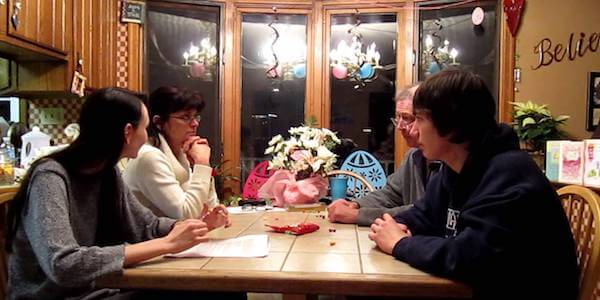 If family therapy sounds like a treatment that would benefit y'all and your loved ones, the all-time course of action is to observe a licensed professional person with whom you can build a practiced working relationship and address the problems your family unit is facing.
If family therapy sounds like a treatment that would benefit y'all and your loved ones, the all-time course of action is to observe a licensed professional person with whom you can build a practiced working relationship and address the problems your family unit is facing.
However, if you lot're not quite gear up for this step, or there are obstacles between you and getting treatment, in that location are many exercises and suggestions that you may find to be good alternatives.
The exercises and techniques beneath are meant to be used within the context of a therapeutic working relationship, merely some also have applications for those who wish to explore the possibilities of family therapy earlier committing to long-term handling with a therapist. If y'all are a therapist or other mental health professional person, you may detect these exercises to exist useful additions to your therapy toolbox.
The Phenomenon Question
This practice tin can be used in private, couples, or family unit therapy, and is intended to assistance the client(s) explore the blazon of future they would similar to build. We all struggle at times, but sometimes the struggle is greater because we simply do non know what our goals really are.
The Miracle Question is an excellent style to help the client or clients probe their ain dreams and desires. When used in the context of couples or family unit therapy, it can assistance clients in understanding what their significant other or family member needs in order to be happy with their human relationship.
This Miracle Question is posed as follows:
"Suppose tonight, while you slept, a miracle occurred. When you lot awake tomorrow, what would be some of the things y'all would discover that would tell you life had suddenly gotten meliorate?"
(Howes, 2010)
While the customer may give an answer that is an impossibility in their waking life, their answer tin nevertheless exist useful. If they do requite an impossible answer, the therapist tin dive deeper into the clients' preferred miracle with this question: "How would that make a difference?"
This question aids both the customer and the therapist—the client in envisioning a positive futurity in which their bug are addressed or mitigated, and the therapist in learning how they can all-time assist their customer in their sessions.
Yous can acquire more well-nigh this exercise using the Miracle Worksheet.
Colored Candy Go Around
If yous're looking for a fun and creative icebreaker or introduction to family unit therapy, this exercise can be a bang-up style to start.
To appoint in this exercise with your family, you need a parcel of Skittles, M&Ms, or a similar colorful candy. Distribute vii pieces to each family member, and instruct them to sort their candy by color (and refraining from eating it only nevertheless!).
Next, enquire a family fellow member to option a color and share how many they have. For however many candies of this color they have, instruct them to requite the same number of responses to the following prompts based on the color:
- Dark-green – words to draw your family;
- Purple – ways your family has fun;
- Orange – things y'all would like to improve about your family;
- Red – things you worry about;
- Yellow – favorite memories with your family.
Family Therapy Exercises. Image Courtesy of Wikimedia.
When the first family member has given their answers, tell them to choose the next family member to reply the same prompt based on the number of candies that person has.
Once the prompt has been answered, the candies can be eaten.
When all family members have responded to these prompts, initiate a discussion based on the answers provided by the family unit. The following questions can facilitate discussion:
- What did y'all learn?
- What was the most surprising thing you lot learned about someone else?
- How will y'all work towards making changes/improvements?
Given the high sugar content in this practise, you tin see that this is a swell game to play with young children! If this sounds like a useful exercise that you would like to effort with your family, you tin observe further data and instructions on page 3 of this PDF from therapist Liana Lowenstein.
Emotions Ball
This is a elementary exercise, requiring but a ball and a pen or mark to write with. It is oftentimes used with children and teenagers in many contexts, as it takes the pressure off of talking about emotions for those who may be uncomfortable sharing their feelings.
A beach ball is a perfect ball for this activity—big enough to write several emotions on and easy to throw back and forth in a circle. Write several emotions on the ball, such as "blithesome," "alone," "giddy," or "sad."
Gather your family into a circle and brainstorm to toss the brawl back and forth between family unit members. When a family unit member catches the ball, take them describe a time when they felt the emotion facing them. Alternatively, yous could have the catcher act out an emotion, an activity specially suited for children.
The intent of this do is to talk over emotions with your family unit and do listening to one another and expressing your feelings.
You can read more about this practice here.
The Family Gift
This exercise can aid a therapist to get to know a family better. If you lot are using it without the guidance of a therapist, it tin assist yous to further your understanding of your own family unit and provoke thoughtful discussion.
To requite this exercise a attempt, gather a variety of fine art supplies and a souvenir handbag. Explain to the family that they are going to create a gift from the materials provided. This gift will be a gift for the whole family, that everyone in the family wants. They must decide together on this gift and how it can be used within their family.
They have 30 minutes to decide on this gift and craft information technology. One time they have created the gift, they must place it in the gift purse. Inside the context of family unit therapy, this exercise provides the therapist with a look at the inner workings of the family, how they make decisions and complete tasks equally a unit of measurement.
If y'all are engaging in this practise as a family without the presence of a therapist, information technology can help you to outset a meaningful conversation.
Utilize these questions or prompts to facilitate the give-and-take:
- Draw your gift.
- Tell how you each felt as you were creating your gift.
- Who made the decisions? For example, who decided what the gift should be?
- Were two or more than people in your family able to work well together?
- Did anyone cause any difficulties or disagreements, and if so, how was this handled?
- Is there anything about the way you did the activeness that reminds yous of how things piece of work in your family at home?
- How tin the gift help your family unit? What else tin can assist your family?
At that place is a wealth of data to exist gained from observing these types of interactions or engaging in these kinds of discussion.
To read more most this do, see pages 3 and 4 of the PDF mentioned earlier.
Mirroring Activeness
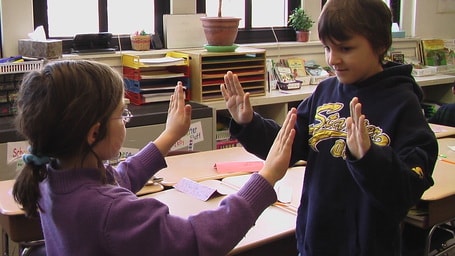 This fun practise is a great way to assist family members relate to each other and work together.
This fun practise is a great way to assist family members relate to each other and work together.
The activity tin can be explained to a family by the therapist with the following instructions:
"I desire you to stand in front of me simply right there (pointing to a spot well-nigh two anxiety in forepart of the practitioner). You are going to be my mirror. Everything I do you will try to copy, but the trick is to copy me at exactly the same time that I am doing it, so that y'all are my mirror. I will go slowly so y'all have a chance to think about where I will be moving and so that we can do it exactly at the same time. We can't touch each other. I will lead first and then y'all will take a turn leading. Ready? Hither nosotros go!"
Get-go, the therapist can model this practice with 1 of the family members, and so that person can take a turn leading another.
This is an especially useful exercise for children, but information technology can be used with family members of whatsoever age. Information technology requires the family members to give each other their full attending, cooperate with one another, and communicate with both words and trunk language.
Information technology as well allows the family unit members to go more in tune with ane another and can be applied with siblings, a parent, a kid, or even couples in marriage counseling.
To run into the instructions and read more about this exercise, see page 20 of this booklet, besides from Liana Lowenstein.
Genogram
A genogram is a schematic or graphic representation of a client's family tree. However, unlike the typical family tree, the genogram provides far more than information on the relationships among members of the family.
It can be used to map out blood relations, medical conditions in the family, and, most often in the case of family therapy, emotional relationships.
Genograms comprise 2 levels of data—that which is nowadays on the traditional family tree and that which provides a much more comprehensive look at the family:
- Bones Data: proper name, gender, date of nativity, engagement of death (if any);
- Additional Information: education, occupation, major life events, chronic illnesses, social behaviors, nature of family relationships, emotional relationships, social relationships, alcoholism, depression, diseases, alliances, and living situations (GenoPro, 2017).
Past including this additional information, the therapist and customer(s) tin can work together to identify patterns in the family unit history that may have influenced the client'southward electric current emotions and behaviors. Sometimes the simple human activity of mapping out and observing this information can make articulate things that were previously unnoticed.
The data on emotional relationships can include points of interest and any aspects of the human relationship that may accept impacted the client(southward), such as whether the human relationship is marked by abuse, whether a marriage is separated or intact, if a human relationship is characterized by dearest or indifference, whether a human relationship could exist considered "normal" or dysfunctional, etc.
This exercise could be completed individually, but it is likely to be virtually effective when completed in conjunction with a qualified professional person.
You tin can learn how to use them in family therapy here.
Recommended Books
i. The Seven Principles For Making Marriage Work: A practical guide from the international bestselling human relationship skilful – John Gottman
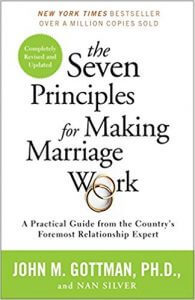
This is an excellent read for any non-professionals who wish to larn more than nearly what family therapy tin exercise for couples.
Although this is intended for married couples, any individual in a long-term relationship tin can do good from this resource of practical wisdom.
Discover the book on Amazon.
2. Why Marriages Succeed or Fail – John Gottman
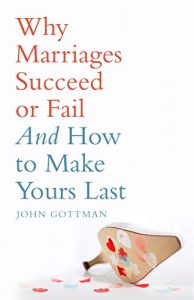
Another entry from Dr. Gottman, this book provides an in-depth look at the inner workings of union and gives advice on how to ensure that your marriage is 1 of the successful ones.
Notice the book on Amazon.
3. Family unit Therapy: Concepts and Methods – Michael Nichols and Sean Davis
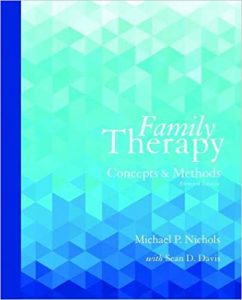
Those with only a casual interest in family therapy may not find much of involvement in this book, but anyone who wishes to gain a deeper understanding of the theory and do of family therapy will detect this volume invaluable.
Information technology gives the reader a solid foundation in the techniques, methods, and academic foundations of family therapy.
If you are interested in becoming a family therapist, or simply learning more than near the practice of therapy within the context of the family unit, this book is a perfect place to start.
Find the book on Amazon.
four. Essential Skills in Family unit Therapy: From the Kickoff Interview to Termination – JoEllen Patterson, Lee Williams, Todd Yard. Edwards, Larry Chamow, Claudi Grauf-Grounds, and Douglas H. Sprenkle

This book is a fantastic resources for those with little or no feel in family therapy.
The language is elementary and accessible, and each chapter provides a guide for students and newly minted therapists who wish to prepare for their first sessions.
Topics include intake and assessment, treatment planning, building and maintaining the therapeutic relationship, and problem-solving when treatment is non progressing.
Notice the book on Amazon.
5. The Family unit Therapy Handling Planner – Frank Chiliad. Dattilio, Arthur Eastward. Jongsma Jr., and Sean D. Davis
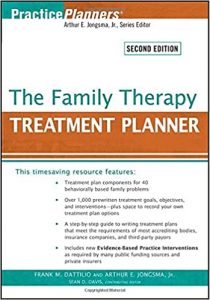
This is another helpful resources for new therapists.
The Family Therapy Treatment Planner will assistance the therapist in planning treatment for clients, dealing with health insurance companies and health providers, and navigating the complex ocean of rules and regulations.
In add-on, this book includes many treatment plan options, a sample handling plan, and guidelines on dealing with the most common presenting bug for family unit therapists.
Notice the book on Amazon.
A Take-Abode Message
Family therapy is a way for you and your family to learn how to maintain healthy family relationships, communicate effectively with family members, and work cooperatively to solve family problems. This type of therapy is unique, in that issues are viewed through a broader lens and equally part of the complex organization of the family.
This perspective allows family therapists to assist families get to the root of their problems and facilitates healing for all members of the family, whether the trouble is related to substance corruption or addiction, abuse, mental health disorders, unexpected or dire circumstances, or just the ordinary everyday stress we all struggle with on occasion.
This piece described the benefits and goals of family therapy, introduced four of the virtually common types of therapy, assorted family unit counseling with family psychotherapy, and provided examples of the exercises and techniques used in family therapy.
My hope is that you find this information useful whether you are interested in engaging with a family therapist, becoming a family therapist, or just learning more about family therapy.
If you have ever participated in family therapy or if y'all have adept family therapy in your work as a mental wellness professional, nosotros'd beloved to hear near your experiences in the comments. Did you observe engaging in family therapy helpful?
Did you become to reap the benefits described here? If you take skillful family unit therapy, what are some of the most valuable things you have learned from your do?
Cheers for reading!
We promise you enjoyed reading this article. Don't forget to download our three Positive Relationships Exercises for complimentary.
- 10 Acre Ranch. (2017, January 23). 10 Acre Ranch. Retrieved from https://www.10acreranch.org/web log/2017/01/23/five-benefits-family unit-therapy/
- American Addiction Centers. (2017). The benefits of family therapy. Forterus. Retrieved from http://forterustreatment.com/therapy/family unit-therapy/
- http://www.drpatrick.com/
- Eder, A. What is the difference between counseling & psychotherapy? Ashley EderCounseling & Psychotherapy. Retrieved from http://world wide web.ashleyeder.com/counseling-psychotherapy/
- "Family Therapy". (2014, January fourteen). Skilful Therapy. Retrieved from http://www.goodtherapy.org/larn-about-therapy/modes/family unit-therapy
- Family unit therapy. (2017A). In Encyclopedia of Children's Health. Retrieved from http://libguides.dixie.edu/c.php?g=57887&p=371718
- Family therapy. (2017B). In Encyclopedia of Mental Disorders. Retrieved from http://www.minddisorders.com/Del-Fi/Family-therapy.html
- GenoPro. (2017). Introduction to the genogram. GenoPro. Retrieved from https://www.genopro.com/genogram/
- Herkov, M. (2016). Virtually family therapy. Psych Fundamental. Retrieved from https://psychcentral.com/lib/nearly-family unit-therapy/
- Howes, R. (2010, Jan 17). The ten coolest therapy interventions: Introduction. Psychology Today. Retrieved from https://www.psychologytoday.com/weblog/in-therapy/201001/the-ten-coolest-therapy-interventions-introduction
- Schwartz, A. (2009, March 31). Family therapy: A different arroyo to psychotherapy. Mental Help. Retrieved from https://world wide web.mentalhelp.cyberspace/blogs/family-therapy-a-unlike-approach-to-psychotherapy/
- Teen Treatment Center. (2014, March 20). The benefits of family therapy. Teen Treatment Centre. Retrieved from https://www.teentreatmentcenter.com/weblog/the-benefits-of-family-therapy/
Source: https://positivepsychology.com/family-therapy/
0 Response to "Board of Marriage and Family Therapy Michigan Admin Rules"
Post a Comment